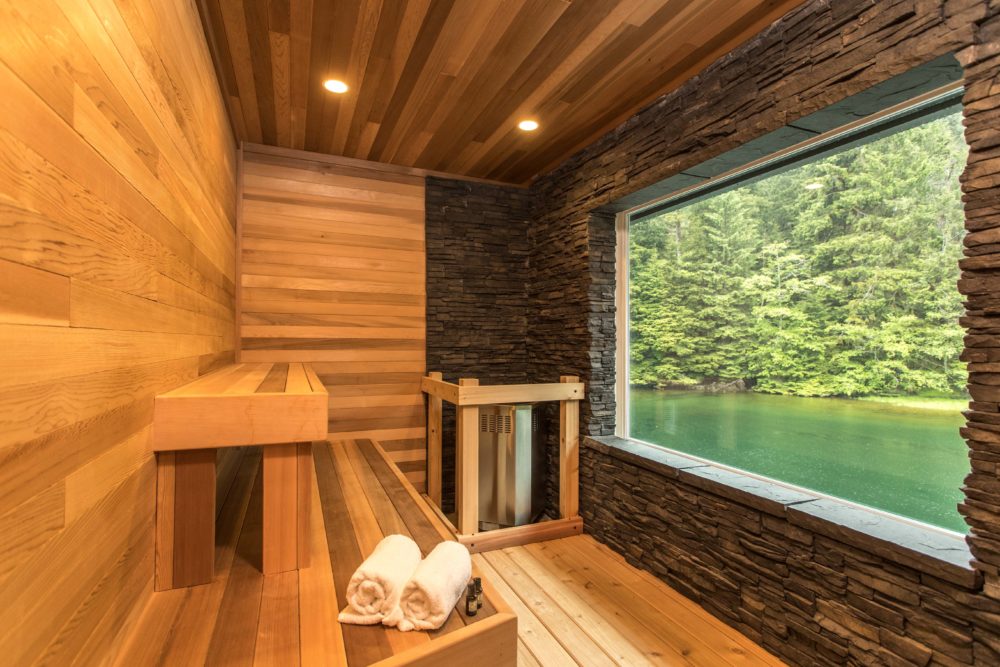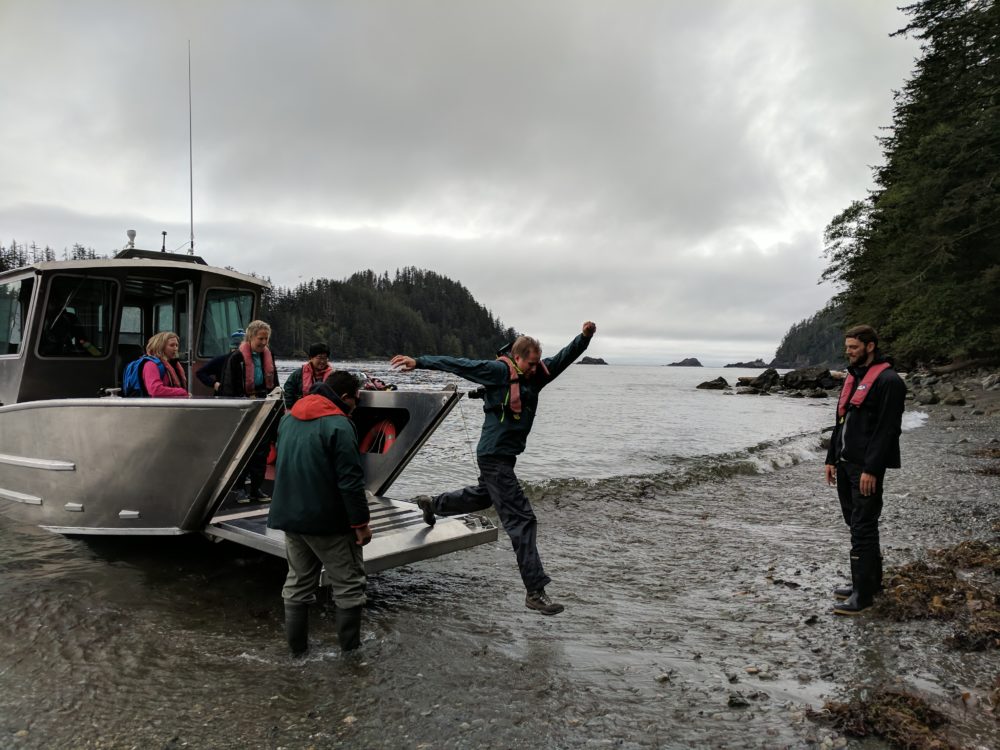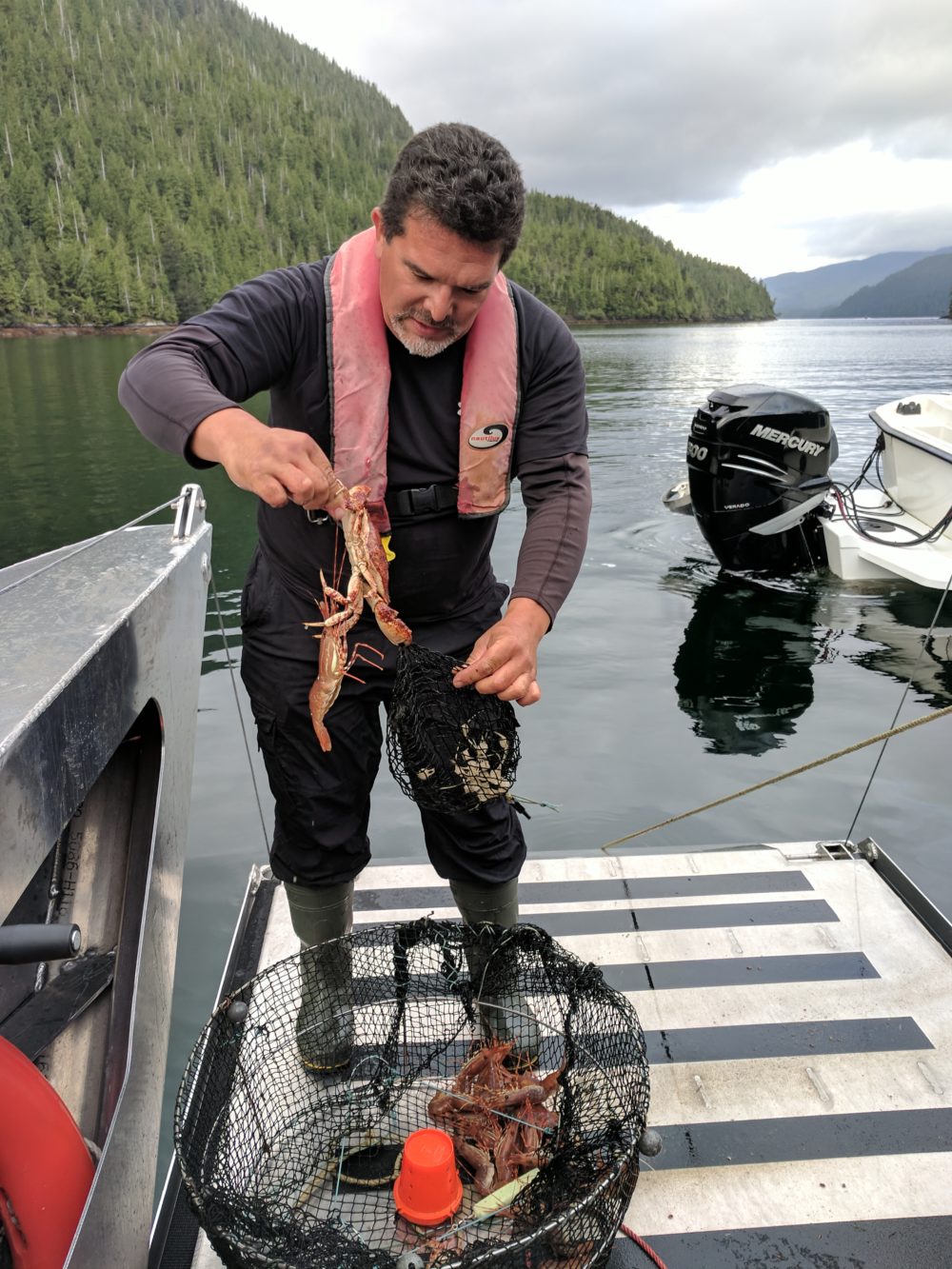
Flying into Ocean House on Haida Gwaii. Photo by Ben Giesbrecht
Mentioning Haida Gwaii engenders deep reverence in listeners, regardless of whether they’ve visited this legendary archipelago off the coast of British Columbia.
Perhaps reverence is prompted by those swirling mists often shrouding the islands. Perhaps it’s Haida Gwaii’s enchanted forests of mosses and towering red cedars and Sitka spruce. Possibly it’s the mortuary and house (totem) poles leaning haphazardly, staring out to sea, mute guardians of Haida culture.
But there’s another palpable, indomitable spirit here: the Haida. Despite more than a century of persecution—residential schools and banning of their potlatch gatherings—they now stride forward while protecting their culture.
Where to stay
During my fourth visit to Haida Gwaii, my reverence deepened while visiting Ocean House, a luxury 12-room eco-lodge at Stads K’uns GawGa (Peel Inlet).
My first glimpse from the helicopter’s approach revealed its magical setting. Serenely floating in a protected, otherwise undeveloped inlet, it’s embraced by sea and towering forests.
Nature meets culture in design
After the warm welcome from staff who line the helicopter pad to greet guests, I was immediately taken with the lodge’s interior. Think spruce and cedar juxtaposed with rough-hewn rock and soothing pearl-white bedrooms with scarlet appointments.

Ocean House Lodge on Haida Gwaii
Everywhere, iconic Haida art intrigues, whether it’s the spa’s cedar carvings, printed black-and-scarlet Haida cushions recalling traditional blankets, woven cedar hats, or masks.

Ocean House sauna with a view. Photo by Kyler Vos
Meeting Haida chiefs
However, it was meeting Haida chiefs and cultural ambassadors who shape-shifted my visit to a deeply memorable experience. Their presence allows us to immerse ourselves in Haida philosophy, life and the landscape they call home.
Haida historian and cultural ambassador Captain Gold accompanied my group on several outings, as did Ocean House’s indispensable outside operations manager, Sascha “Luu Tydals” Jones. Onsite at the lodge, weaver Gladys “Jiixa” Vandall patiently and with great humour offered workshops on weaving roses from split cedar bark that she had gathered.

Cultural ambassador and weaver Gladys “Jiixa” Vandall cleans and splits the cedar bark that cultural ambassador Cohen Isberg (Gidin Kuns) collected for her. Once in strips she can use them to weave her roses during her workshop with visitors. Photo by Katharine Fletcher.
Unparalleled views
Once in my room, I grounded myself by gazing from my balcony overlooking that special landscape where forest meets ocean.
Taking deep breaths of the salty air, I consciously de-cluttered my mind, opening it to the scents of land and ocean, and the sounds of wind amid the trees. As I meditated, a bald eagle flew by. Surely it was a good omen.
An abandoned Haida village
Soon our group boarded a motorboat, bouncing about on large swells, facing a stiff ocean breeze and penetrating drizzle with Haida storyteller and guide Cohen Isberg. Our destination? Kaysuun, a once-thriving now-abandoned Haida village.

Landing on the beach takes a leap of faith. En route to Kaysuun Village. Photo by Katharine Fletcher.
After alighting on a stony beach, he led us inland on a path where pungent ocean fragrances gave way to damp, earthy scents of mosses and spruce.
Abruptly, Isberg stopped. With a wave of his arm, he revealed a depression in the forest floor lined with moss-clad logs: the foundations of a longhouse.
Pausing, the young man explained how honoured he feels that his elders chose him to be the keeper of Haida stories. His quiet, shy demeanor belied a strong voice: soon the forest was keening to his drumming and song. At its conclusion, he paused as if allowing the waiting forest to absorb his ancient tale. Had the forest longed for the sound of such stories?
Haida Gwaii’s magnetism is empowering
To me, such palpable feelings of magic and mystery are part and parcel of the reverence Haida Gwaii inspires in my soul. Surely this land longs for Haida memories to be rekindled.
Isberg explained that Kaysuun was a winter village because of the protection of the forest. But come spring, villagers left, transporting their house poles to other sites. Clever architectural design meant houses were modular. Villagers would disassemble the longhouses, putting planks on canoes to make large “rafts,” then paddle to their summer village. There they reassembled the homes, and collected fish and other foods, which they dried and stored for winter. Before the weather turned, the migration back to such villages as Kaysuun was repeated.
The freshest seafood

Ocean House cuisine crispy seaweed appetizer. Photo by Jordan Dyck
Back at the lodge, we dined on the freshest of fresh seafood. Another day, Captain Gold and Sascha Jones guided us on a sea odyssey. We ate shrimp captured in traps, live from the sea, as well as sea urchins. Talk about foraging from the wild: both were definitively the freshest “sashimi” I have ever tasted.

Sascha Jones (whose Haida name is Luu Tydals) is the Outside Operations Manager for Ocean House. Here he takes visitors out to check traps for crab and shrimp. Photo by Katharine Fletcher.
Taking flight in a seaplane
As anticipated, my visit to nearby SGang Gwaay remains one of my best experiences ever. Just like the fly-in to Haida Gwaii and Ocean House, visiting SGang Gwaay meant another fantastical flight. This one via seaplane, hugging the western, exposed coast of Moresby Island.

Spectacular views of ocean and the Haida Gwaii archipeligo are revealed during our flight to Rose Harbour. From there, we transferred onto a Zodiac boat to SGang Gwaay. Photo by Katharine Fletcher.
The morning’s sun-splashed blue sky revealed ultramarine waters turning to white froth as waves relentlessly collided with the rocky coastline. Our pilot indulged our wonder, flying out to sea to see humpback whales. Viewing their massive forms from aloft created yet another astonishing Haida Gwaii moment.
UNESCO World Heritage Sites
Upon landing on the water, we transferred adeptly to a zodiac, then motored to SGang Gwaay UNESCO World Heritage Site. Because it’s protected, only a few, always-guided groups can visit.

The ancient village of SGang Gwaay. Some house poles still stand facing the cove, and we can imagine what the scene would have been when these longhouse poles were homes sheltering the people of this once bustling village. Photo by Katharine Fletcher.
We waited for a previous tour to end, bobbing about in our boat until invited to land. Haida Watchmen—both men and women who stay on-island to guard the village from human scavengers—greeted us and took us to the house and mortuary poles. Interestingly, the Haida allow nature’s elements to transform these: some tilt wildly, others have fallen and are covered in moss.
Mortuary poles stand guard
Haida watchman and guide Teresa Russ impressed us by interpreting each pole’s story and answered questions sensitively. When asked how Haida feel about some poles being in museums scattered worldwide, she explained: “As much as we want them back, we appreciate they are loved and appreciated throughout the world.”
Many of SGang Gwaay’s poles face the cove. I imagined how impressive the approach must have been when the village was thriving. In fact, back at Ocean House, Haida historian Captain Gold recalled his first visit, after paddling some 250 kilometres in stormy seas before landing on the rocky beach.
In my mind, I saw all these children pouring out of the village, running about me, splashing in the water and kelp… The rest of the village opened up to me: I could see it alive. I saw this lady packing a bent box. So many people laughing and welcoming me… I landed on the beach stern first: it’s what we did to show we come in peace, because if you landed bow first on the beach, you could be dangerous.
With such stories spun by Haida ambassadors, with Gladys “Jiixa” Vandall’s cedar workshops’, and with the meeting of ocean, forest, rock, eagle and bear… who cannot succumb to the spirit of Haida Gwaii?
HaiCo: A thriving Haida business
Haida culture is thriving, thanks in part to HaiCo, Haida Enterprise Corporation. This 100 per cent, Haida-owned company owns and operates Ocean House Lodge. It also operates its sister floating inn, The Lodge at Englefield Bay (an impressive fishing destination).
From Ocean Lodge’s architectural design by Haida Gina Mae Schubert, to the eco- and cultural adventure outings led by Haida chiefs and cultural ambassadors, HaiCo is enabling a valuable initiation to the understanding of the Haida’s cultural protection and entrepreneurial aspirations.
For more information, visit:
• Destination British Columbia
• Haida Gwaii Tourism and SGang Gwaay
• Haida Heritage Centre and Museum at Skidegate











No Responses to “Where to Experience Haida Gwaii’s Natural Spirit and Ancestral Culture”